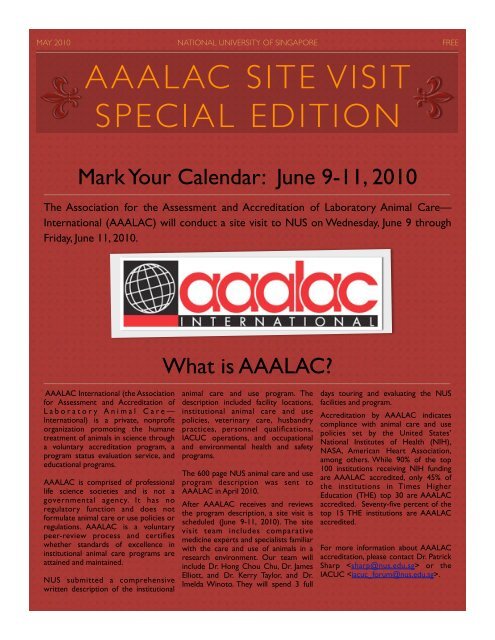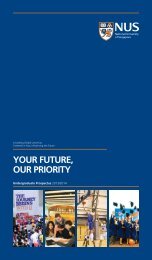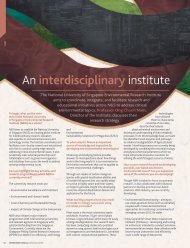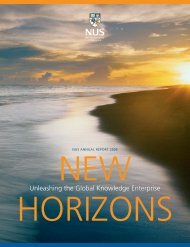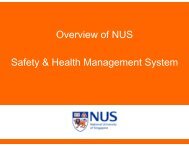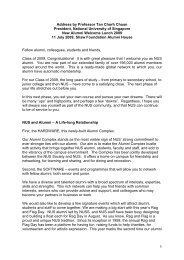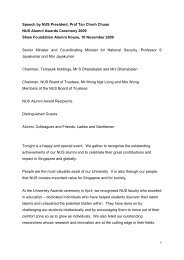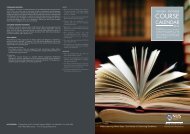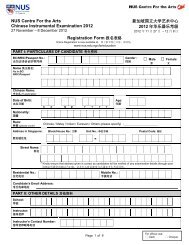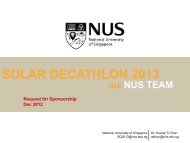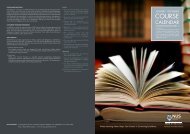AAALAC is Coming - NUS - Home
AAALAC is Coming - NUS - Home
AAALAC is Coming - NUS - Home
Create successful ePaper yourself
Turn your PDF publications into a flip-book with our unique Google optimized e-Paper software.
MAY 2010 NATIONAL UNIVERSITY OF SINGAPORE FREE<br />
<strong>AAALAC</strong> SITE VISIT<br />
SPECIAL EDITION<br />
Mark Your Calendar: June 9-11, 2010<br />
The Association for the Assessment and Accreditation of Laboratory Animal Care—<br />
International (<strong>AAALAC</strong>) will conduct a site v<strong>is</strong>it to <strong>NUS</strong> on Wednesday, June 9 through<br />
Friday, June 11, 2010.<br />
What <strong>is</strong> <strong>AAALAC</strong>?<br />
<strong>AAALAC</strong> International (the Association<br />
for Assessment and Accreditation of<br />
Laboratory Animal Care—<br />
International) <strong>is</strong> a private, nonprofit<br />
organization promoting the humane<br />
treatment of animals in science through<br />
a voluntary accreditation program, a<br />
program status evaluation service, and<br />
educational programs.<br />
<strong>AAALAC</strong> <strong>is</strong> compr<strong>is</strong>ed of professional<br />
life science societies and <strong>is</strong> not a<br />
governmental agency. It has no<br />
regulatory function and does not<br />
formulate animal care or use policies or<br />
regulations. <strong>AAALAC</strong> <strong>is</strong> a voluntary<br />
peer-review process and certifies<br />
whether standards of excellence in<br />
institutional animal care programs are<br />
attained and maintained.<br />
<strong>NUS</strong> submitted a comprehensive<br />
written description of the institutional<br />
animal care and use program. The<br />
description included facility locations,<br />
institutional animal care and use<br />
policies, veterinary care, husbandry<br />
practices, personnel qualifications,<br />
IACUC operations, and occupational<br />
and environmental health and safety<br />
programs.<br />
The 600 page <strong>NUS</strong> animal care and use<br />
program description was sent to<br />
<strong>AAALAC</strong> in April 2010.<br />
After <strong>AAALAC</strong> receives and reviews<br />
the program description, a site v<strong>is</strong>it <strong>is</strong><br />
scheduled (June 9-11, 2010). The site<br />
v<strong>is</strong>it team includes comparative<br />
medicine experts and special<strong>is</strong>ts familiar<br />
with the care and use of animals in a<br />
research environment. Our team will<br />
include Dr. Hong Chou Chu, Dr. James<br />
Elliott, and Dr. Kerry Taylor, and Dr.<br />
Imelda Winoto. They will spend 3 full<br />
days touring and evaluating the <strong>NUS</strong><br />
facilities and program.<br />
Accreditation by <strong>AAALAC</strong> indicates<br />
compliance with animal care and use<br />
policies set by the United States’<br />
National Institutes of Health (NIH),<br />
NASA, American Heart Association,<br />
among others. While 90% of the top<br />
100 institutions receiving NIH funding<br />
are <strong>AAALAC</strong> accredited, only 45% of<br />
the institutions in Times Higher<br />
Education (THE) top 30 are <strong>AAALAC</strong><br />
accredited. Seventy-five percent of the<br />
top 15 THE institutions are <strong>AAALAC</strong><br />
accredited.<br />
For more information about <strong>AAALAC</strong><br />
accreditation, please contact Dr. Patrick<br />
Sharp or the<br />
IACUC .
Why are the benefits of<br />
pursuing <strong>AAALAC</strong> accreditation?<br />
Represents quality<br />
Promotes scientific validity<br />
Provides assurance in a global marketplace<br />
Demonstrates accountability<br />
Provides a confidential peer-review<br />
Stimulates continuous improvement<br />
It’s a recruiting tool<br />
What are the site v<strong>is</strong>itors assessing?<br />
The site v<strong>is</strong>itors were provided the<br />
600-page <strong>NUS</strong> program description<br />
outlining the animal care and use<br />
program and facilities. During their 3-<br />
day v<strong>is</strong>it they will v<strong>is</strong>it more than just<br />
the animal housing areas. They will v<strong>is</strong>it<br />
animal procedure areas, including<br />
researcher’s laboratories where animals<br />
are used in the course of research,<br />
teaching, and testing. While evaluating<br />
the program description, inspecting<br />
facilities, and interviewing members of<br />
the <strong>NUS</strong> animal care and use<br />
community, the site v<strong>is</strong>itors will be<br />
working to answer the following<br />
questions:<br />
Is the university in compliance with<br />
the NACLAR Guidelines and other<br />
internationally accepted standards?<br />
Is the animal care and use program<br />
adequately supported (authority and<br />
funding) from the top levels of<br />
admin<strong>is</strong>tration?<br />
Have previously identified problems<br />
been addressed and corrected?<br />
Is the IACUC effective?<br />
Are the animal use projects and<br />
procedures being conducted approved<br />
by the IACUC?<br />
Are individuals using and caring for<br />
animals properly trained and skilled?<br />
Is the occupational health and safety<br />
program for animal care and use<br />
personnel effective?<br />
Are animal husbandry, veterinary<br />
care, animal surgery, and euthanasia<br />
performed in accordance with the<br />
regulations and internationally accepted<br />
standards?<br />
Are the physical facilities (including<br />
caging, rooms, buildings, ventilation<br />
systems, etc.) designed and maintained<br />
in accordance with the regulations and<br />
internationally accepted standards?<br />
Are hazardous agents used in<br />
animals conducted with appropriate<br />
safeguards of other animals, personnel,<br />
and the environment?<br />
Expect site v<strong>is</strong>itors to direct special<br />
attention to research projects involving<br />
prolonged physical restraint, food/water<br />
restriction, multiple major survival<br />
surgeries, category E protocols, and the<br />
use of hazardous agents.<br />
When encountering site v<strong>is</strong>itors during<br />
their rounds on June 9-11, please<br />
welcome them and respond to their<br />
questions in an honest and forthright<br />
manner; feel free to network by asking<br />
them about their home institution’s<br />
animal care and use program.<br />
Please direct your questions and<br />
c o n c e r n s a b o u t t h e A A A L AC<br />
accreditation to Dr. Patrick Sharp<br />
or the IACUC<br />
<br />
With your ass<strong>is</strong>tance, we<br />
anticipate a successful<br />
accreditation site v<strong>is</strong>it!!<br />
Prior to the <strong>AAALAC</strong> site v<strong>is</strong>it, if you w<strong>is</strong>h to schedule an IACUC/Comparative<br />
Medicine Educational Lab meeting or a pre-<strong>AAALAC</strong> “Lab Walk-<br />
Through", please contact the IACUC at iacuc_forum@nus.edu.sg or 62861 or<br />
Comparative Medicine through Dr. Patrick Sharp at sharp@nus.edu.sg or 67164.<br />
Thank you again for your continued dedication to <strong>NUS</strong>’ animal care and use program.<br />
2
Do you have any suggestions?<br />
Sure! Here are some suggestions to<br />
ass<strong>is</strong>t your preparation for the<br />
upcoming <strong>AAALAC</strong> site v<strong>is</strong>it….<br />
1. Know <strong>AAALAC</strong> i s t h e<br />
Association for the Assessment and<br />
Accreditation of Laboratory Animal<br />
Care—International and that it <strong>is</strong> a<br />
non-profit organization compr<strong>is</strong>ed of<br />
professional societies in the life<br />
sciences. Accreditation <strong>is</strong> based on a<br />
voluntary, peer-review process.<br />
2. Know the site v<strong>is</strong>it will occur<br />
June 9-11, 2010. A detailed schedule will<br />
be provided to facility managers in<br />
advance, and will be available to others<br />
on request from the IACUC office<br />
.<br />
3. The site v<strong>is</strong>itors include:<br />
•Dr. Hong Chou Chu, Level<br />
Biotechnology, Inc.<br />
•Dr. James Elliott, University of Texas<br />
San Antonio<br />
•Dr. Kerry Taylor, Kansas State<br />
University<br />
•Dr. Imelda Winoto, US Naval Research<br />
Unit<br />
Members of the <strong>AAALAC</strong> site v<strong>is</strong>it<br />
team manage and operate animal care<br />
programs. The site v<strong>is</strong>it team<br />
understands and appreciates our efforts<br />
of programmatic improvement. Since<br />
they manage programs, they will be<br />
familiar with various problem areas. The<br />
best approach? Find problems ... Solve<br />
problems.<br />
4. Be familiar with the NACLAR<br />
Guidelines. The full text <strong>is</strong> available at<br />
http://www.ava.gov.sg/NR/rdonlyres/<br />
C64255C0-3933-4EBC-<br />
B869-84621A9BF682/13557/<br />
Attach3_AnimalsforScientificPurposes.P<br />
DF.<br />
5. Update all research staff<br />
members on animal care and<br />
use, including students and temporary<br />
laboratory members. Those working<br />
with animals should be acquainted with<br />
the basics of animal care and use<br />
including, occupational health and<br />
safety, contacting a veterinarian, IACUC<br />
approval of animal use procedures. Use<br />
th<strong>is</strong> information to conduct a review<br />
session with all laboratory members.<br />
Are the research staff performing only<br />
those procedures outlined in their<br />
IACUC-approved protocol?<br />
6. Use only the anesthesia and<br />
analgesia agents outlined in the<br />
IACUC-approved protocol. Their use<br />
needs to be documented; if it <strong>is</strong>n’t<br />
documented, it didn’t happen. Contact a<br />
Comparative Medicine veterinarian if<br />
you have any questions regarding<br />
anesthesia or analgesia.<br />
7. Animals are not to be<br />
maintained outside the<br />
vivarium more than 12 hours,<br />
unless specifically stated in the IACUCapproved<br />
protocol. When the IACUC<br />
has approved housing animals outside<br />
the vivarium, the attending veterinarian<br />
must have access to the housing area<br />
and a room husbandry log must be<br />
completed.<br />
8. Follow the recommendations<br />
of the veterinarian. Treat or<br />
euthanize your animals as prescribed by<br />
the veterinarian. Please do not treat or<br />
use anything not l<strong>is</strong>ted on the IACUCapproved<br />
protocol (antibiotic,<br />
analgesic, or other agents) without first<br />
consulting with the veterinarian.<br />
9. Be familiar with the humane<br />
endpoints outlined in the IACUCapproved<br />
protocol and ensure they are<br />
followed and documented where<br />
applicable.<br />
10. Be familiar with your<br />
IACUC-approved protocol. Every<br />
staff member should be familiar with<br />
the IACUC-approved protocol for their<br />
projects, and ensure that the animals<br />
are only used according to the IACUCapproved<br />
protocol. Expect the site<br />
v<strong>is</strong>itors to compare the actual<br />
experimental activities with those<br />
described in the IACUC-approved<br />
protocol. The IACUC-approved<br />
protocol for each project <strong>is</strong> available<br />
from the principal investigator. Please<br />
have copies of all your IACUCapproved<br />
protocols where your<br />
research staff can review them.<br />
11. Document all treatments.<br />
Record that you have performed the<br />
treatments as prescribed by the<br />
veterinarian, and save the records for<br />
subsequent IACUC, AVA, or <strong>AAALAC</strong><br />
review.<br />
12. Clean up, but don’t close<br />
down. Site v<strong>is</strong>itors expect things to be<br />
orderly, but they don’t expect deserted<br />
laboratories or animal facilities;<br />
deserted facilities will not make the<br />
best impression. Knowledgeable<br />
research personnel are encouraged to<br />
make themselves available to d<strong>is</strong>cuss<br />
scientific objectives of their animal use<br />
projects.<br />
13. Training. Ensure all the research<br />
staff have completed the necessary<br />
animal, facility, and safety training.<br />
14. Answer questions in an<br />
honest and forthright manner.<br />
Don’t hesitate to answer a questions<br />
with “I don’t know” if that’s the case;<br />
you could add that you’d contact<br />
Comparative Medicine or the IACUC<br />
to find out.<br />
15. The site v<strong>is</strong>itors must<br />
adhere to all entry requirement<br />
and restrictions for your area, such<br />
as PPE, traffic patterns, light schedules,<br />
etc. For special clothing requirements,<br />
facility managers should be prepared to<br />
supply clothing and/or other protective<br />
gear for at least 8 people (3-4 site<br />
v<strong>is</strong>itors, 3-4 facility representatives).<br />
16. Notify area housekeeping<br />
staff. They will want to be extra<br />
vigilant about the cleanliness of public<br />
areas of buildings during the site v<strong>is</strong>it.<br />
17. If you are removing rodents<br />
from the vivarium. Place the cages<br />
(with the water bottles turned upside<br />
down during transit) inside opaque<br />
plastic bags before transporting them<br />
through hallways or service elevators.<br />
Th<strong>is</strong> minimizes the spread of rodent<br />
allergens in public areas and decreases<br />
animal v<strong>is</strong>ibility.<br />
18. Don't re-cap needles. Place<br />
the uncapped needle and syringe<br />
directly into the ‘sharps’ container.<br />
19. Review all vivarium<br />
procedures. Hours of operation;<br />
c o n t a c t s ; p e r s o n a l p ro t e c t i ve<br />
equipment (PPE); use of the surgery<br />
and procedure rooms; use of the<br />
anesthetic machines and other<br />
common equipment.<br />
3
Do you have any suggestions?<br />
20. Review IACUC policies. E.g.,<br />
survival surgery, euthanasia, tumor size,<br />
etc. For more information v<strong>is</strong>it the<br />
IACUC website at www.nus.edu.sg/<br />
iacuc.<br />
21. Review aseptic surgery<br />
requirements. (1) anesthetize; (2)<br />
generously shave or clip fur; (3) apply<br />
three alternating scrubs using Betadine<br />
or Chlorhexidine and 70% <strong>is</strong>opropyl<br />
alcohol.<br />
22. All surgical rodents require<br />
analgesia and antibiotics. Unless<br />
otherw<strong>is</strong>e approved by the IACUC,<br />
surgery patients require at least 72hr of<br />
analgesia and 5 days of antibiotics.<br />
C o n s u l t a v e t e r i n a r i a n o n<br />
recommended drugs and dosages.<br />
23. Check your lab for expired<br />
drugs and for nonpharmaceutical-grade<br />
drugs: All<br />
expired drugs intended to be used on<br />
animals must be d<strong>is</strong>carded. Nonpharmaceutical-grade<br />
drugs (e.g., Sigma,<br />
F<strong>is</strong>her) must be approved by the<br />
IACUC prior to their use on animals.<br />
24. Secure all compressed gas<br />
cylinders: All cylinders (O2, CO2,<br />
N2, N2O) must be properly restrained<br />
with chains or straps secured to the<br />
wall or by mounting them on a stable<br />
cart or dolly.<br />
25. When animals attack: Review<br />
procedures for what to do in case of an<br />
animal bite: (1) wash and clean the<br />
wound, (2) report to your superv<strong>is</strong>or,<br />
(3) report to the Occupational Health<br />
Facility, (4). notify Comparative<br />
Medicine (re-training in animal handling<br />
may be needed).<br />
26. Review chemical hazard<br />
procedures: Become familiar with<br />
the chemical hazards you may be<br />
exposed to by reading the Material<br />
Safety Data Sheets (MSDS) for<br />
substances kept in your research, study<br />
or surgery areas.<br />
27. Formalin perfusion: Be sure to<br />
use formalin only inside a fume hood or<br />
on a down-draft or back-draft table.<br />
28. Keep food away from t<strong>is</strong>sues<br />
and chemicals: Don't store your<br />
lunch or other food or beverages for<br />
human consumption in the same<br />
re f r i g e r a t o r w h e re yo u s t o re<br />
laboratory chemicals, biohazards or<br />
animal t<strong>is</strong>sues/carcasses.<br />
\")*!L&!!"#2!0&&]!Z&-^!<br />
If you or your laboratory do not<br />
understand or have a clear<br />
answer for any of these items,<br />
please contact Dr. Patrick Sharp<br />
sharp@nus.edu.sg or the IACUC<br />
iacuc_forum@nus.edu.sg. The<br />
animal program wants to help<br />
your laboratory be well prepared<br />
during the upcoming <strong>AAALAC</strong><br />
accreditation site v<strong>is</strong>it!<br />
W(*#!P(%(*!W;-=(=)3!<br />
✁<br />
✁<br />
Comparative Medicine<br />
Obtaining Veterinary Care<br />
✁<br />
CeLS Vivarium<br />
Dr Enoka Bandularatne<br />
•T: 651-62261<br />
•E: lacbesd@nus.edu.sg<br />
Normal Business Hours<br />
MD1<br />
Dr. Jonnathan Peneyra<br />
•T: 651-63790<br />
•E: lacpjl@nus.edu.sg<br />
Pathology and Diagnostic Services<br />
Dr. Scott Trasti<br />
•T: 651-68170<br />
•E: trasti@nus.edu.sg<br />
MD4 Vivarium<br />
Dr. Shannon Heo<br />
•T: 651-67870<br />
•E: lachsys@nus.edu.sg<br />
Director, Comparative Medicine<br />
Dr. Patrick Sharp<br />
•T: 651-67164<br />
•E: sharp@nus.edu.sg<br />
Emergency, After Hours,<br />
Weekends, and Holidays<br />
T: 9001-3073<br />
4
Uhhh, I could really use a checkl<strong>is</strong>t…<br />
Check!! We hope th<strong>is</strong> will ass<strong>is</strong>t in your<br />
final preparations…<br />
Labels<br />
Check that all animals are<br />
properly identified with species,<br />
strain/stock/breed, source, principal<br />
investigator, pertinent dates (birth,<br />
arrival, capture, etc.), and especially the<br />
IACUC approval number.<br />
Check for proper labels on all<br />
containers of all solutions and dry<br />
goods to prevent accidental m<strong>is</strong>use or<br />
injury.<br />
Check that all hazard labels<br />
are current. Remove obsolete hazard<br />
signs; make sure signs are prominently<br />
posted for current hazards. Contact<br />
OSHE if you have any questions<br />
D<strong>is</strong>card all expired items:<br />
drugs, treatments, fluids, foods, etc. If it<br />
has an expiration date, properly d<strong>is</strong>pose<br />
of the materials on or before that date.<br />
Husbandry<br />
Ensure all feed <strong>is</strong> fresh (within<br />
6 months of the labeled milling date for<br />
most species) and appropriate for the<br />
species.<br />
Check that all animal caging<br />
<strong>is</strong> cleaned and sanitized on an<br />
appropriate schedule.<br />
Ensure all animals are clean<br />
and dry. Cages should be spot<br />
changed if the bedding appears wet or<br />
overly soiled.<br />
Veterinary Care<br />
All ill or injured animals<br />
must be reported to<br />
Comparative Medicine<br />
veterinary staff. Remind everyone<br />
using your facility. Information on<br />
obtaining veterinary care <strong>is</strong> found on<br />
page 4 and <strong>is</strong> posted in the animal<br />
facilities.<br />
Micro and Macro Animal<br />
Environment<br />
Check that animals are<br />
provided with adequate<br />
housing space. See the NACLAR<br />
Guidelines for specific information on<br />
space requirements. No overcrowded<br />
cages! It <strong>is</strong> particularly important to pay<br />
special attention to cages in which<br />
litters of rodents are present; these can<br />
quickly and easily become too<br />
crowded.<br />
Check that caging <strong>is</strong> in good<br />
repair and of appropriate<br />
design for the animals housed.<br />
No sharp edges, no escape routes, no<br />
rust/corrosion, no cracks.<br />
Check animal room<br />
temperatures. They should be stable<br />
(varying not more than a few degrees<br />
each day) and appropriate for the<br />
animals housed. Make sure that<br />
minimum-maximum thermometers are<br />
reset daily.<br />
Check animal room<br />
ventilation. Everyone who enters an<br />
animal room should perform the “Sniff<br />
Test.” If the room <strong>is</strong> stuffy, malodorous,<br />
o r e x p e r i e n c i n g t e m p e r a t u r e<br />
fluctuations, the ventilation should be<br />
evaluated and corrected as necessary.<br />
Check light timers. Make sure<br />
the lights really go off at night by staying<br />
late or coming in early at least once<br />
every 6 months.<br />
Facility/Equipment<br />
Maintenance<br />
Check washers and<br />
sterilizers. Don’t depend on the<br />
machine settings and read-outs. Use<br />
independent indicators (strips, vials,<br />
etc.) to ensure sanitation and sterility.<br />
Ensure log books are up to date and<br />
available for review.<br />
Check that mo<strong>is</strong>ture-proof<br />
outlet/switch covers or ground<br />
(earth)-fault interrupters are<br />
installed. They will protect you from<br />
electric shock hazards in your area.<br />
Check your security system.<br />
Are your animal room doors locked? Is<br />
video sur veillance periodically<br />
reviewed?<br />
Check that all surfaces in<br />
your animal housing rooms are<br />
in good repair, vermin-proof (no<br />
holes or gaps), and sanitizable (nonporous).<br />
Check your animal room<br />
housekeeping. Get into those hardto-reach<br />
spots. Get rid of anything that<br />
<strong>is</strong> not absolutely necessary for daily<br />
animal care/use.<br />
Vermin problems? Notify pest<br />
c o n t r o l a n d O E D. T h e y a r e<br />
knowledgeable about the special<br />
requirements of vermin control in<br />
animal research facilities.<br />
Storage<br />
Check that storage of food,<br />
bedding, caging, etc. <strong>is</strong> separated<br />
from storage of chemicals, cleaners, or<br />
other hazardous agents. Food and<br />
bedding must be stored off the floor<br />
and away from the wall. Opened or<br />
torn bags of food or bedding must be<br />
stored in a vermin-proof, leak-proof<br />
container with a tight-fitting lid.<br />
Check that any substance<br />
that may be toxic to animals,<br />
but required for animal husbandry or<br />
use (cleaners, experimental agents,<br />
etc.), are stored in a cabinet or other<br />
secondary container to ensure that the<br />
animals cannot come into contact with<br />
hazardous substances.<br />
Ensure animal carcasses are<br />
stored in dedicated<br />
refrigerators/freezers. The<br />
carcasses should be double-bagged<br />
using opaque bags.<br />
All trash receptacles must be<br />
leak-proof and have tight<br />
fitting lids. In addition there should<br />
be adequate numbers of properly<br />
labeled waste receptacles strategically<br />
placed throughout the facilities. Don’t<br />
forget to empty them regularly!<br />
S-#A)-)*(&+!4"#']3(%*!<br />
5
Uhhh, I could really use a checkl<strong>is</strong>t…<br />
Personnel<br />
Check that all personnel<br />
working with animals are properly<br />
trained and l<strong>is</strong>ted on the IACUCapproved<br />
protocol. Training <strong>is</strong><br />
mandatory and available at <strong>NUS</strong><br />
through the monthly Responsible Care<br />
and Use of Laboratory Animals<br />
(RCULA) species-specific courses.<br />
Descriptions of the training classes, and<br />
schedules and reg<strong>is</strong>tration information,<br />
<strong>is</strong> available on the IACUC website,<br />
www.nus.edu.sg/iacuc<br />
Eating, drinking, smoking, or<br />
applying cosmetics in not<br />
allowed in animal facilities.<br />
Remind everyone using your facility.<br />
Check that the emergency<br />
and on call veterinarian<br />
information (nights, weekends,<br />
emergencies, etc.) <strong>is</strong> posted in<br />
each facility.<br />
Know the Animal Concern<br />
Hotline and report anything you see<br />
that troubles you to the Animal<br />
Concern Hotline (see below)<br />
Relax, be friendly, and convey your<br />
enthusiasm, pride, and sense of<br />
tremendous responsibility toward<br />
ensuring ethical and humane care and<br />
use of animals.<br />
✁<br />
Please print, cut, laminate, and post<br />
✁<br />
Animal Concern Hotline<br />
6516-2644<br />
The National University of Singapore <strong>is</strong> strongly committed to<br />
the ethical and humane care and use of animals in research,<br />
teaching, and testing. The Animal Concern Hotline<br />
(6516-2644) provides a mechan<strong>is</strong>m for <strong>NUS</strong> staff members and<br />
the general public to report any matter of concern about<br />
humane aspects of laboratory animal care and use. The IACUC<br />
will promptly investigate any and all reports submitted and<br />
maintain confidentiality, within University guidelines, regarding<br />
the source of information it receives.<br />
IF YOU SEE ANYTHING THAT<br />
TROUBLES YOU, PLEASE CALL!!<br />
6


